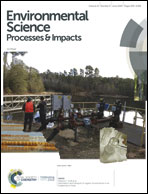An EXAFS study for characterizing the time-dependent adsorption of cesium on bentonite
Abstract
Bentonite is considered for use as a buffer material in the final disposal repositories of radioactive waste. Long-lived 135Cs with a half-life of 2.3 × 106 years is a key radionuclide in high-level waste, and lots of 137Cs with a half-life of 30.2 years exists in low-level waste. Therefore, the adsorption of Cs on bentonite is a critical issue in evaluating the long-term safety of radioactive waste disposal. In this study, EXAFS techniques were used to characterize the time-dependent process from the beginning of adsorption to equilibrium. From the results of this study, we found changes including to the Cs adsorption sites, the Cs–O distance between Cs and the oxygen atom, and that the adsorption of Cs ions occurred before the reaction reached equilibrium. The fraction of OS complexes when Cs was adsorbed on bentonite can refer to the CN (Cs–O1st)/CN (Cs–O2nd) ratio of coordination numbers, and this study found that the OS complex was the major adsorption species when Cs adsorbed onto bentonite. In addition to the ratio CN (Cs–O1st)/CN (Cs–O2nd) providing information on the adsorption site, we also discussed the change of Cs–O1st and Cs–O2nd bond distances to identify the adsorption sites at different times. Comparing the XRD patterns of montmorillonite and bentonite, we found that the interlayer collapsed after Cs was adsorbed onto montmorillonite, but it expanded after Cs was adsorbed onto bentonite. From the results of EXAFS fitting, we found that the movement of Cs ions was from regular interlayer sites to expanded interlayer sites, which caused the interatomic distance of Cs–O2nd to decrease with an increase in time. It was revealed that the adsorption of Cs on bentonite occurred in two steps. The first step includes the rapid uptake of Cs by attachment to the oxygen atoms of the H2O molecules at the regular interlayer sites, especially for the OS complexes. The second step includes a slower process where dehydrated Cs ions move from the regular interlayer sites to the expanded interlayer sites. In this study, Cs L3-edge EXAFS spectroscopy was conducted for the Cs adsorbed on bentonite to identify the Cs adsorption sites over time, as this is important in evaluating the mobility of Cs in the environment. These results are beneficial in finding the process of Cs adsorption on bentonite, which could be used for the design of the final disposal of spent nuclear fuel.



 Please wait while we load your content...
Please wait while we load your content...